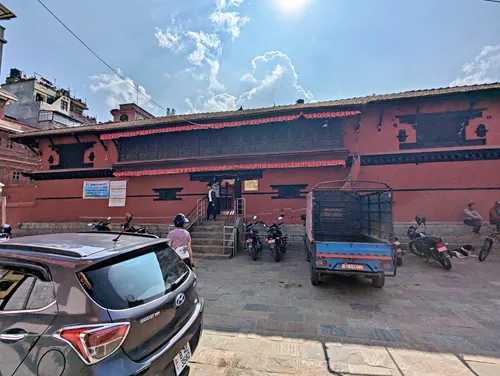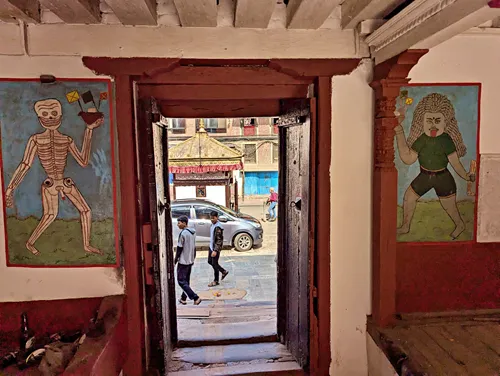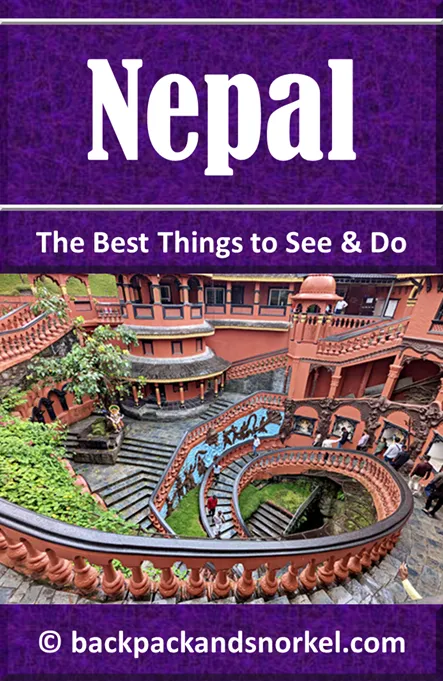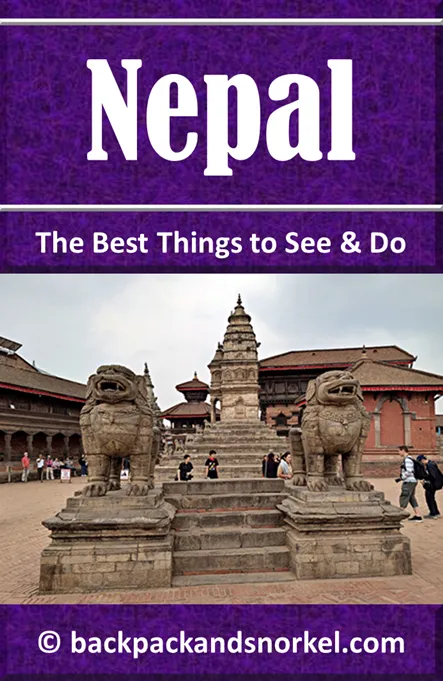Lokakirti Mahavihar Guide: History, Art & Visiting Patan's Monastery - Nepal Purple Travel Guide
(map, reviews)
This is Premium Content! To access it, please download our
Backpack and Snorkel Purple Travel GuideLokakirti Mahavihar is one of the 18 main monasteries of Patan. It is well known as a starting point for the historical dance of eight mother Goddesses during the Dasain festival. The monastery houses a central image of Achyov Buddha with an image of Pragya Parmita and Khadchheri on its right and left sides.
The monastery is believed to have been built between 1217 and 1255 AD.




Here at Backpack and Snorkel Travel Guides, we typically promote self-guided walking tours.
But we realize that not everybody likes to walk by themselves in a foreign city. So, just in case that you rather go with ab guide: NO PROBLEM! Please see the Viator tours below.
free GuruWalk tours
paid Viator tours
Origin of the name Lokakirti Mahavihar
The name Lokakirti Mahavihar is derived from Sanskrit, where ‘Loka’ means ‘world’ and ‘Kirti’ means ‘fame’ or ‘glory’. Combined with Mahavihar (‘great monastery’), the full name can be interpreted as ‘The Great Monastery of Worldly Fame’. This reflects both its spiritual aspirations and its historical importance as one of the most important monasteries within the Buddhist monastic network of Patan.
Lokakirti Mahavihar: A Center of Faith and Community
Lokakirti Mahavihar is one of the 25 traditional baha or bahal monasteries that form the religious and social backbone of Patan’s Newar Buddhist community. These monastic courtyards are typically home to sacred images, votive stupas, and prayer halls, and serve not only as places of worship but also as community centers for rituals, festivals, and social gatherings.
Information on the images displayed at Lokakirti Mahavihar
1) Achyov Buddha
Achyov Buddha, more commonly known as Akshobhya Buddha, is a significant figure in Mahayana and Vajrayana Buddhism.
He is one of the Five Dhyani Buddhas, also called the Five Wisdom Buddhas or Five Jinas. These Buddhas represent different aspects of enlightenment and are associated with specific directions, colors, and elements.
Meaning and Symbolism:
‘Akshobhya’ means ‘immovable’ or ‘unshakable’ in Sanskrit.
He symbolizes the wisdom of the mirror, representing the ability to see reality clearly and without distortion.
He is associated with the eastern direction and the color blue.
Iconography:
Akshobhya is typically depicted seated in a meditative posture with the earth-touching mudra (symbolic hand gesture in Buddhist and Hindu iconography), symbolizing his unwavering resolve.
His blue color represents his pure and unwavering nature.
2) Pragya Parmita
Pragya Parmita (Prajnaparamita) is a significant figure in Mahayana Buddhism. She is not a Buddha, but rather a Bodhisattva and the personification of the ‘Perfection of Wisdom’ sutras. Pragya Parmita represents the core concept of ‘prajna’, which translates to wisdom or insight, specifically, she embodies the wisdom that understands the emptiness (shunyata) of all phenomena.
She is therefore referred to as Mother of All Buddhas, as it is through the perfection of wisdom that Buddhas attain enlightenment. This is not a literal mother, but a symbolic one.
Prajnaparamita Sutras:
The Prajnaparamita Sutras are a collection of Mahayana Buddhist texts that explore the concept of emptiness.
Pragya Parmita is the embodiment of these teachings.
Iconography:
She is often depicted as a beautiful female figure, sometimes holding a Prajnaparamita Sutra or a lotus.
Her iconography can vary depending on the specific tradition.
3) Khadchheri
Khadchheri (also spelled Khachheri or Khadcheri) is a form of the Buddhist deity Avalokiteshvara, known as the bodhisattva of compassion. In this particular manifestation, Khadchheri is represented as Four-Armed Avalokiteshvara (Chaturbhuja Avalokiteshvara) and is especially revered in the Newar Buddhist tradition of the Kathmandu Valley.
The name Khadchheri is derived from Tibetan or Newar Buddhist contexts, where this form is commonly worshipped as a protector and symbol of mercy.
Iconography of Khadchheri
Khadchheri is typically depicted with four arms, each holding symbolic objects:
One pair of hands is joined at the heart in anjali mudra (gesture of prayer).
One hand holds a rosary (mala), symbolizing continuous prayer.
The other holds a lotus flower, representing purity and spiritual awakening.
This peaceful and serene form is meant to embody compassion in action, and is often associated with recitation of mantras, especially the well-known ‘Om Mani Padme Hum’.
Lokakirti Mahavihar: Role in Newar Buddhism
In the Newar Vajrayana Buddhist tradition, Khadchheri holds a central place in daily devotion and ritual life. Images or statues of Khadchheri can be found in many mahavihars (Buddhist monasteries) across Kathmandu Valley, particularly in Patan and Bhaktapur.
Back to your self-guided tour
Author: Rudy at Backpack and Snorkel
Bio: Owner of Backpack and Snorkel Travel Guides. We create in-depth guides to help you plan unforgettable vacations around the world.
Other popular Purple Travel Guides you may be interested in:
Like this Backpack and Snorkel Purple Travel Guide? Pin these for later:





